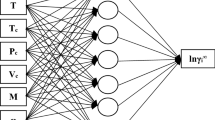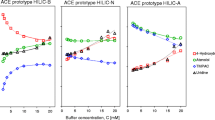Summary
The concentrations of modifier (methanol or acetonitrile) and surfactant (sodium dodecyl sulfate, SDS) in the running buffer are important factors influencing the mobility of analytes in micellar electrokinetic chromatography (MEKC). Response surfaces of the effective mobility can be used to predict mobility as a function of the buffer composition.
This paper describes the modeling, by multiple linear regression and by use of a back-propagation neural network, of the response surfaces of the effective mobility of cocaine and related compounds, of fluvoxamine and its possible impurities, and of a mixture of alkylphenones. Special attention has been paid to selection of the proper order of the regression models, to selection of the proper network configuration, and to the predictive quality of the models. The regression models were selected by backward elimination of non-significant terms starting with a full second-order polynomial model. The proper network configuration was selected by finding the optimum number of hidden neurons by lateral inhibition and subsequent determination of the optimum number of training cycles by a cross-validation method.
On the basis of the multiple determination coefficient,R 2, the descriptive performances of the neural network and the regression models are almost the same. However, the predictive performance of the regression models and the neural network models are approximately equal for migration in MEKC. The relative prediction error of the effective mobility is ca 2.5% for cocaine and related compounds, 1 – 7% for the alkylphenones, and 1.5 – 2.2% for fluvoxamine and its possible impurities; this is approximately the same order of magnitude, or slightly higher, than the relative standard deviation of the replicate measurements.
Similar content being viewed by others
References
Terabe, S.; Otsuka, K.; Ichikawa, K.; Tsuchiya, A.; Ando, T.Anal. Chem. 1984,56, 111–113.
Terabe, S.; Otsuka, K.; Ando, T.Anal. Chem. 1985,57, 834–841.
Vindevogel, J.; Sandra, P.Introduction to Micellar Electrokinetic Chromatography, Hüthig, Heidelberg,1992.
Corstjens, H.; Billiet, H.A.H.; Frank, J.; Luyben, K.Ch.A.M.J. Chromatogr. 1995,715, 1–11.
Schoenmakers, P.J.Optimization of Chromatographic Selectivity, Elsevier, Amsterdam,1986.
Jimidar, M.; Bourguignon, B.; Massart, D.L.Anal. Chim. Acta 1995,310, 27–42.
Khaledi, M.G.; Smith, S.C.; Strasters, J.K.Anal. Chem. 1991,63, 1820–1830.
Quang, C.; Strasters, J.K.; Khaledi, M.G.Anal. Chem. 1994,66, 1646–1653.
Van Zomeren, P.V.; Hilhorst, M.J.; Coenegracht, P.M.J.; de Jong, G.J.J. Chromatogr. 2000,867, 247–259.
Havel, J.; Peña, E.M.; Rojas-Hernández, A.; Doucet, J.P.; Panaye, A.J. Chromatogr. 1998,793, 317–329.
Quang, C.H.; Khaledi, M.G.J. Chromatogr. 1994,659, 459–466.
Yang, Q.; Smeyers-Verbeke, J.; Wu, W.; Khots, M.S.; Massart, D.L.J. Chromatogr. 1994,688, 339–349.
Jidmar, M.; Hamoir, T.; Degezelle, W.; Massart, D.L.; Soyens, S.; Van der Winkel, P.Anal. Chim. Acta 1993,284, 217–225.
Farková, M.; Peña-Méndez, E.M.; Havel, J.J. Chromatogr. 1999,848, 365–374.
Metting, H.J.; Coenegracht, P.M.J.J. Chromatogr. 1996,728, 47–53.
Yasui, S.Proc. 2nd Int. Conf. Fuzzy Logic and Neural Networks, Izuka, July 17–22,1992.
Hilhorst, M.J.; van Hout, M.W.J.; Somsen, G.W.; Franke, J.P.; de Jong, G.J.J. Cap. Elec. 1998,5, 159–164.
Hendriks, M.M.W.B.Nonlinear Retention Modeling in Liquid Chromatography, PhD Thesis, University of Groningen, The Netherlands,1996 (www.ub.rug.nl/eldoc/dis/science/m.m.w.b.hendriks/).
Sacchero, G.; Bruzzoniti, M.C.; Sarzanini, C.; Mentasti, E.; Metting, H.J.; Coenegracht, P.M.J.J. Chromatogr. 1998,799, 35–45.
Author information
Authors and Affiliations
Rights and permissions
About this article
Cite this article
Metting, H.J., van Zomeren, P.V., van der Ley, C.P. et al. Comparison of migration modeling in micellar electrokinetic chromatography by linear regression and by use of an artificial neural network. Chromatographia 52, 607–613 (2000). https://doi.org/10.1007/BF02789760
Received:
Revised:
Accepted:
Issue Date:
DOI: https://doi.org/10.1007/BF02789760




